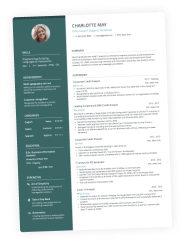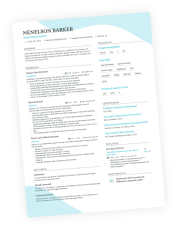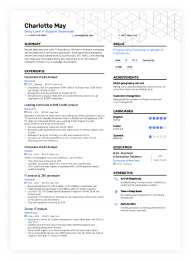AI now plays a central role in how applicants create resumes and apply for jobs. Yet “AI” can mean very different things in resume builders—from simple keyword scanners to tools powered by large language models (LLMs). Most users don’t really know what’s behind the label or how it affects hiring outcomes.
Many platforms promise faster, smarter, and ATS-friendly resume creation. But beneath the marketing lies a confusing reality: without understanding how these tools work, job seekers risk wasting time and money.
That’s why it’s crucial to choose a proven, transparent AI resume builder. In this guide, we’ll review the top options to help you decide which is the best AI resume builder for your needs—one that helps you craft standout applications and land interviews.
Key takeaways
- When choosing an AI resume builder, look for well-defined functionalities that offer value.
- AI transparency matters—verify what models are used before you commit.
- Consider how a product fits into your workflow—does it match your preferred approach?
- Take time to evaluate AI resume output quality—does it meet the expectations of your role/industry?
- Don’t neglect using your own judgment when polishing your resume—human review and custom tailoring are still highly important to impress employers.
What to look for in a good AI resume builder
When choosing an AI resume builder, look for specific capabilities that'll help you create better applications and get you closer to interviews. It should be mentioned that AI transparency and guidance play a key role in the quality of the resumes you’ll be able to build.
Let’s go over what makes a great product.
Core AI capabilities in resume builders
| Capability | What to look for |
|---|---|
| Real AI value | Tools that clearly explain what the AI actually does—resume tailoring, rewriting, real-time improvement suggestions, translation, etc. |
| Tailoring depth | Is the AI able to tailor an entire resume to a job description? This is useful for job-specific applications and saves you lots of time. |
| Control and editability | Does the editor show AI suggestions as optional edits (diff/accept/reject) and let you adjust the writing tone (e.g., junior to senior)? |
| Promptability | Can you input custom prompts or context, and get similar responses each time? This gives you extra control over the process. |
| Before/after samples | Are you able to see clear before/after examples or previews so you can judge the quality of the AI writing? |
| Model and training transparency | Which AI model is used (ChatGPT, in-house, etc.) and do they use uploads from users to train models? If not specified, treat this as an unknown risk. |
| Data handling and deletion | Where is your input processed and stored, and how can you delete your data? Look for an easy deletion request and explicit retention windows. |
| Security and compliance | Make sure the site uses HTTPS and encrypts stored files—look for SOC2/ISO badges or GDPR compliance if you’re sharing sensitive info. |
| Labeling and “hallucination” policies | “Hallucination” in the context of AI is when a model invents or states plausible-sounding but false or unsupported facts. Vendors should acknowledge these risks and provide guidance to avoid fabricated metrics. |
It’s worth mentioning that resume builders existed before AI was cool—a proper AI-integrated product should cover the basics and continuously improve upon them.
Such as:
Key AI resume builder functionalities
- Resume customization: Control over layout, design, fonts, colors, and sections.
- ATS and recruiter awareness: Good tools optimize for both systems and human reviewers.
- Export formats and compatibility: Ability to export in ATS-friendly file format (PDF/DOCX).
- Workflow integration: Does it ease your job-search flow? Features like editable resume templates, cover letter generation, LinkedIn import, job tracker, and multiple document versions save hours of work.
- Multilingual and localization: Check language support and country-specific conventions if you’re applying internationally.
Now that we’ve set the standards, let’s take a look at the best AI resume builders the market has to offer, arranged in alphabetical order.
1. Enhancv
Enhancv’s AI resume builder uses various ChatGPT models, including GPT-4o, GPT-4o-mini, and 4o-nano. We’re mindful of new models being released, such as GPT-5, and test them vigorously to see what produces the highest quality resume writing and tailoring outputs.
Note that newer models aren’t necessarily better at tasks, as pointed out in this massive meta-analysis study by researchers at Cornell University.
it should be stated, we don’t use your data and content to train AI models.
Now, let’s take a look at what our best AI resume builder yet brings to the table.
Enhancv core AI usage
- AI Resume Checker: You can upload your current resume and our free resume checker will perform 19 crucial checks (such as ATS parse rate, resume design, and content quality).
- Inline AI Assistant: Detects mistakes and offers suggestions as you edit your document..
- Prompt-engineered outputs: All you see are buttons and drag & drop functionalities, but the AI is indeed there in the background, quickly working on your content.
- AI resume tailoring: You can tailor your resume to any job description with just a couple of clicks. The tool optimizes keywords without stuffing.
- AI suggestions highlights: You’re able to apply judgment and reject or accept them. You can see your ATS score adjust in real time as you make changes to your application.
- Rewrite and polish: Real-time AI suggestions to make generic lines more persuasive and achievement-focused.
- Summary Generator: Upload your current document and the AI will summarize your experience in seconds.
- Bullet Point Generator: You can task the built-in AI assistant to generate ideas for new bullet points.
- Cover Letter Generator: AI cover letter generation based on your resume.
- LinkedIn-to-resume conversion: Just paste in the link to your profile and turn your LinkedIn into a resume.
- Localization: One-click auto-translation of documents to 29 additional languages, including Spanish, French, German, and Chinese.
The core AI capabilities, combined with our ATS-friendly resume templates and high degree of format and design customization make Enhancv one of the most versatile and well-rounded AI resume builders in the world.
Now let’s take a look at the advantages of using Enhancv.
Pros
- High-level AI value: Enhancv’s AI integration handles lots of heavy lifting and makes resume building way faster and easier for you.
- Real-time feedback: The ATS Checker and inline AI Assistant guide you toward finalized resume versions that have the highest chance of success.
- Integrated workflow: Quicker resume tailoring and a built-in Job Application Tracker streamline your job-hunting efforts.
- Minimized friction: From AI prompting to design and formatting, you don’t need any special skills to build a great application.
We don’t overpromise. We don’t pretend Enhancv is magic. We acknowledge the challenges job applicants face and work toward the best AI resume features to solve them.
But can we keep it real and acknowledge the downsides of our own product? There are some.
Cons
- Promptability is locked in: The reason behind this is that we can’t have any wiggle room when it comes to job description tailoring and keyword targeting.
- Hallucination risk and translation mistakes: While ChatGPT is a leading LLM, and chances are low, we acknowledge these risks.
2. Jobscan
Jobscan doesn't disclose what AI model it uses in its resume builder.
Its website states:
“…tools like Jobscan’s AI resume builder are specifically designed to ensure ATS compatibility and job-specific tailoring.”
This suggests they might be using their own AI model.
Here’s what their product offers.
Core AI usage
- Resume to job description matching: Uses algorithms (and features backed by machine learning) to compare your resume to a pasted job description and produce a score plus prioritized keyword/skill gaps.
- Tailoring suggestions: Recommends specific edits, keyword placements, and formatting tips to improve ATS parsing and score.
- Template and optimization guidance: Offers ATS-friendly templates and step-by-step actions to increase alignment with different applicant tracking systems.
- Generative help: Jobscan emphasizes matching and scoring over full generative rewrite—any AI writing features are generally focused on turning the matching insights into suggested lines rather than free-form prose.
Pros
- Data-first approach: Measurable score and prioritized fixes make it clear what to change to improve ATS compatibility.
- Actionable, prioritized suggestions: Tells you which keywords and sections will move the needle most, and which are practical for targeted applications.
- Strong resources for ATS-aware formatting: Templates and export guidance reduce the chance that formatting breaks parsing.
Cons
- Less emphasis on generative prose: Jobscan may be less polished than GPT-heavy writers—you might have to combine with a separate writing tool.
- Leaning heavily on exact keyword matching: It may push users toward mechanical, context‑less phrasing that inflates match scores but reads poorly to human reviewers.
- Subscription requirements for deep features: Some of the most useful scoring and comparison tools live behind paid tiers.
3. Kickresume
Kickresume also resorts to ChatGPT integration. The primary AI model it uses is GPT-4.
Here’s what the resume builder focuses on.
Core AI usage
- Full-resume tailoring: Paste a job description and Kickresume analyzes it, recommends keywords, and rewrites content to better match the job description.
- Content generation: Creating bullets, summaries, and cover letters.
- Full AI resume rewrite: Includes an option to completely rewrite an existing resume.
- Site and portfolio generation: Option to create a personal website/resume site alongside resume exports.
Pros
- High-quality generative copy: GPT-4 positioning yields natural-sounding, recruiter-ready prose in many user tests and reviews.
- Fast tailoring workflow: Quick resume tailoring and integrated cover-letter creation save time for high-volume applicants.
- Accessible pricing and free tier: Free tier available and competitively priced Premium plans (various billing options).
- EU/GDPR posture: Kickresume states EU hosting/GDPR compliance, which is reassuring for European users.
Cons
- Training on anonymized user data: Kickresume’s privacy policy says it may use strictly anonymized user documents to train and develop systems.
- Model/version mapping unknown: While the site advertises GPT-4, it doesn’t always specify which features use which model/version or whether other LLMs are used for specific workflows.
- Generic outputs risk: As with any high-speed generative tool, outputs can sometimes read generically—expect to edit for voice and specificity.
4. Novorésumé
Novorésumé uses ChatGPT in their chatbot. However, they don’t disclose what model they’re using in their resume builder.
Here’s what it offers.
Core AI usage
- Template-aware rewriting: AI helps rephrase bullets and summaries to fit Novorésumé’s streamlined templates and character limits.
- Keyword/ATS guidance: Offers keyword suggestions and formatting tips focused on ATS-friendly structure.
- Multilingual support and localization: Provides guidance for different CV conventions and supports multiple languages (verify exact language list).
Pros
- Recruiter-vetted formats: Templates are designed with recruiter preferences in mind, reducing needless formatting errors.
- Simple, clear outputs: Helps users keep bullets concise and focused—good for roles/industries where brevity matters.
- Good for international users: Explicit attention to localization and language support (confirm supported languages for your region).
Cons
- Generative depth: if you want long-form, creative rewriting or advanced metric synthesis, Novorésumé’s AI may be more conservative—expect to edit for voice and detail.
- Data loss: When you upload an existing resume (e.g. PDF) to Novorésumé and try to convert it, data is lost or misparsed, forcing you to retype omitted content.
- Limited in customization: With constraints on layout, section additions, and flexible edits, you get reduced control over how your resume is structured.
5. Rezi
According to its product pages, Rezi uses OpenAI’s GPT-3 technology. There are mentions of their own “carefully trained AI model,” but details around that are undisclosed.
Rezi Core AI usage
- AI keyword targeting: Scans job descriptions and recommends/places the right keywords to improve targeting.
- AI Content Writer: Generates metrics-focused bullets and rewrites lines to be more results-oriented.
- Real-time resume checks: Live content analysis and scoring to highlight formatting or content issues that affect ATS parsing.
- Cover letter & document generation: Quick AI drafts for cover letters and other application materials.
- Export and workflow features: PDF/DOCX/Google Drive export, LinkedIn import, and templates optimized for different markets.
Pros
- ATS-focused strength: Rezi’s keyword-targeting and scoring tools are explicitly built to improve ATS compatibility.
- Feature-rich free tier and flexible pricing: A usable free plan plus Pro/Lifetime options make it accessible for budget-conscious users.
- Fast, opinionated workflows: Guided templates and real-time checks speed up creating multiple tailored resumes.
Cons
- Human-readability vs. ATS tradeoff: Heavy keyword optimization can sometimes produce content that’s ATS-friendly but may feel generic to recruiters—watch for overly templated language.
- Model and training transparency: Rezi documents its AI features but doesn't clearly state their AI integration.
- Data use details (training/retention): Rezi publishes a privacy policy and GDPR references, but whether user uploads are used to train models or specific retention windows for resume text are unknown.
6. Teal
Teal advertises their resume builder as AI, but doesn't disclose what model ituses.
Here’s what they offer.
Core AI usage
- Resume tailoring to job descriptions: Analyzes a pasted job description and suggests targeted bullets, keywords, and summary edits to align your resume to the role.
- Contextual templates and snippets: Suggests reusable bullet/snippet libraries for common roles that you can apply across applications.
- Integrated job insights: Uses AI to surface role-specific tips and recommended keywords based on real job listings and market signals.
- Cover letter and ATS checks: Automated generation of cover letters plus basic compatibility checks to improve ATS readability.
Pros
- All-in-one workflow: Resume tailoring, application tracking, and role insights live in the same place. This saves lots of time if you apply to many jobs.
- Job-market-aware suggestions: Recommendations are tied to live job data and job-tracking context, making tailoring pragmatic and campaign-focused.
- Reusable snippet libraries: Good for building a set of vetted bullets you can quickly adapt per application.
Cons
- Generative polish may lag specialist writing: Teal emphasizes workflow and alignment—its generative prose may be less polished than GPT-4–focused writer.
- Functionality limitations: Teal’s AI features sometimes depend on linked job data or integrations, meaning limited or inconsistent functionality if you don’t use its recommended job board sources or its full ecosystem.
- “Templated” content: Some AI suggestions can become repetitive or formulaic across multiple tailored resumes because Teal leans on template-driven snippet libraries, which reduce variety unless you continually customize them.
And now, last but not least.
7. Zety
Zety doesn't disclose what AI model it’s using in its resume builder.
Let's examine its product.
Core AI usage
- Basic tailoring: Provides keyword/phrase suggestions for a target role, though deep full-resume job description tailoring may be more limited than specialist tools.
- Rewrite and polish: AI suggests clearer, more accomplishment-focused wording for bullets and summaries.
- Template-aware suggestions: Edits are offered in the context of the chosen template so text and layout remain consistent across exports.
- Cover letters and short bios: Generative tools produce quick drafts for cover letters and LinkedIn summaries that match the resume tone.
Pros
- Practical guidance: Inline tips and examples help users phrase achievements more concretely.
- Excellent UX: Very approachable editor and templates that look professional to recruiters.
- Good export reliability: PDF/DOCX exports retain design fidelity, which helps with recruiter presentation.
Cons
- Depth of AI tailoring: For specific tailoring to job descriptions or metric extraction, Zety’s AI may be less advanced than GPT-driven tools.
- Generic content: Zety’s AI suggestions often default to generic phrasing based solely on job title, rather than deeply customizing to your actual experience or role context.
- Content and format incompatibility: Because Zety emphasizes visual templates, the AI rewriting sometimes doesn’t adapt well to nonstandard layouts or multi-column formats, causing formatting distortions or truncation when exporting.
Our list of top resume builders concludes here. There are some differences between the products, but no doubt, you can build an outstanding resume with any of them.
However, there are some products out there with a not-so-great AI integration, too.
Red flags in AI resume builders
Not every tool is created with your best interests in mind. Some hide key details, make risky promises, or cut corners that could hurt your applications or privacy.
Here’s what you should be cautious about when choosing an AI resume builder.
Watch out for…
- “Proprietary AI” claims with zero detail: This can be a marketing gimmick. It may just mean they’re using a third-party LLM. This raises questions about who’s really responsible about outputs and how reliable they are.
- Fake testimonials and misleading “recruiter-approved” badges: Some product pages feature unverifiable user testimonials and fake trust gimmicks, which can skew trust.
- Aggressive auto-fill: Some tools mine the web for your data without clear consent. This can cause privacy and accuracy issues.
- Identical-looking outputs: If every resume from a tool looks way too similar, some ATSs could flag them as spammy.
- No version history or exportable raw data: If you can’t export editable source text, then you are locked into a vendor’s user interface. Avoid tools that only give PDFs (you can’t edit those).
- No reproducibility: If running the same prompt more than once gives you wildly different outputs, then there’s no way for you to reproduce one that you like. This makes auditing your resume edits harder and more time-consuming.
- Canned impact templates: In some industries and regions of the world, employers expect particular resume formats. Canned impact templates may not fit into those applications.
Frequently asked questions about AI resume builders
Here are some concise answers to common follow-up questions.
If an AI suggests a claim I didn’t make, who’s responsible if it’s false?
That’s on you. AI resume builders are drafting tools. It’s your responsibility to verify factual claims, metrics, skills, credentials, etc. You’re the decision-maker, so treat AI like a collaborator.
Should I tell recruiters I used AI to write my resume or cover letter?
Generally, you don’t need to disclose that you used an editor. If a recruiter or employer asks about authorship, be honest—they care more about factual truth rather than the wording itself.
NOTE: If a role requires original work as part of the application (e.g., writing samples, code, etc.), follow the job’s rules and cite or disclose AI use if requested.
Can AI safely help with roles that require regulated credentials (medical, legal, security clearance)?
This is something you should be extremely cautious about. You shouldn’t allow AI to invent or rephrase credentials, licenses, or clearance status—in some countries you might be legally liable if you have presented false credentials. For these roles, have human subject-matter reviewers validate every line and follow regulatory disclosure rules.
Is it OK to use multiple tools together (e.g., resume builder for bullet points plus ChatGPT for narrative)?
Yes, you can combine tools strategically. If you have the opportunity to create your own workflow with various tools at your disposal, then do so. Generally, every serious vendor aims to create an AI resume builder that offers a complete solution. But sometimes specific quirks can be limiting factors, so it’s perfectly fine to offload those to other tools.
How can I tell if an AI rewrite actually increased interview chances?
One way to handle this is to do simple A/B tests. For example, send two similar applications (one AI-polished, one baseline) to similar roles or track recruiter response rates over a small sample (10–30 applications should be meaningful). Then measure interviews-per-application and iterate on prompts/settings.
Will AI get me past recruiter screens any faster than a human rewrite?
AI speeds up content tailoring and polishing, but it’s not a guaranteed multiplier. The biggest gains come from quantifying impact across roles from your work history and tailoring to job descriptions. AI can help you draft those quickly, but you must verify them. For best results, you should combine your own judgment with the speed of AI.
Conclusion: AI resume builders are great (but not magical!)
Thanks to AI, resume builders have reached a pretty sweet point of development and usefulness. But don’t neglect human reviewing. No matter what product you choose to build your resume with, use your own judgment and read your content carefully before you send out your applications.
PRO TIP
Here at Enhancv, we’re all about great resume writing! We’ve made thousands of resume examples and guides, so check out the ones for the roles you want to land. You’ll learn tips and tricks that'll help you build even better applications.
Make one that's truly you.



